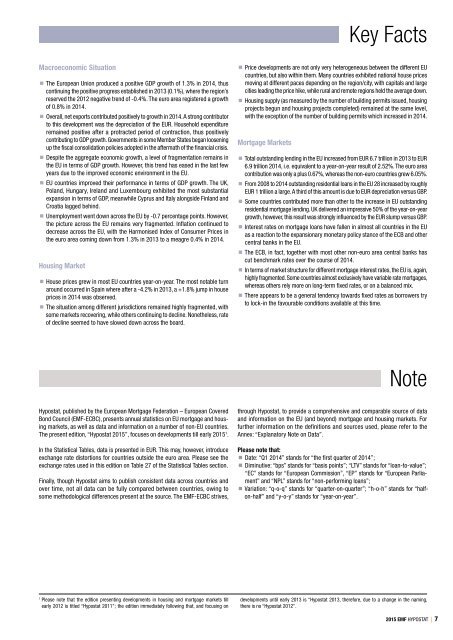Hypostat 2015
On 30 September 2015, the EMF-ECBC published Hypostat 2015 , which is its main statistical report, encompassing data on recent developments in housing and mortgage markets in the EU28 and beyond. Hypostat is the result of a collaborative effort by the European Mortgage Federation’s national delegations and external experts. The publication covers 33 countries – i.e. the EU28 plus Iceland, Norway, Russia, Turkey and the United States.
On 30 September 2015, the EMF-ECBC published Hypostat 2015 , which is its main statistical report, encompassing data on recent developments in housing and mortgage markets in the EU28 and beyond. Hypostat is the result of a collaborative effort by the European Mortgage Federation’s national delegations and external experts.
The publication covers 33 countries – i.e. the EU28 plus Iceland, Norway, Russia, Turkey and the United States.
You also want an ePaper? Increase the reach of your titles
YUMPU automatically turns print PDFs into web optimized ePapers that Google loves.
Key Facts<br />
Macroeconomic Situation<br />
The European Union produced a positive GDP growth of 1.3% in 2014, thus<br />
continuing the positive progress established in 2013 (0.1%), where the region’s<br />
reserved the 2012 negative trend of -0.4%. The euro area registered a growth<br />
of 0.8% in 2014.<br />
Overall, net exports contributed positively to growth in 2014. A strong contributor<br />
to this development was the depreciation of the EUR. Household expenditure<br />
remained positive after a protracted period of contraction, thus positively<br />
contributing to GDP growth. Governments in some Member States began loosening<br />
up the fiscal consolidation policies adopted in the aftermath of the financial crisis.<br />
Despite the aggregate economic growth, a level of fragmentation remains in<br />
the EU in terms of GDP growth. However, this trend has eased in the last few<br />
years due to the improved economic environment in the EU.<br />
EU countries improved their performance in terms of GDP growth. The UK,<br />
Poland, Hungary, Ireland and Luxembourg exhibited the most substantial<br />
expansion in terms of GDP, meanwhile Cyprus and Italy alongside Finland and<br />
Croatia lagged behind.<br />
Unemployment went down across the EU by -0.7 percentage points. However,<br />
the picture across the EU remains very fragmented. Inflation continued to<br />
decrease across the EU, with the Harmonised Index of Consumer Prices in<br />
the euro area coming down from 1.3% in 2013 to a meagre 0.4% in 2014.<br />
Housing Market<br />
House prices grew in most EU countries year-on-year. The most notable turn<br />
around occurred in Spain where after a -4.2% in 2013, a +1.8% jump in house<br />
prices in 2014 was observed.<br />
The situation among different jurisdictions remained highly fragmented, with<br />
some markets recovering, while others continuing to decline. Nonetheless, rate<br />
of decline seemed to have slowed down across the board.<br />
Price developments are not only very heterogeneous between the different EU<br />
countries, but also within them. Many countries exhibited national house prices<br />
moving at different paces depending on the region/city, with capitals and large<br />
cities leading the price hike, while rural and remote regions held the average down.<br />
Housing supply (as measured by the number of building permits issued, housing<br />
projects begun and housing projects completed) remained at the same level,<br />
with the exception of the number of building permits which increased in 2014.<br />
Mortgage Markets<br />
Total outstanding lending in the EU increased from EUR 6.7 trillion in 2013 to EUR<br />
6.9 trillion 2014, i.e. equivalent to a year-on-year result of 2.52%. The euro area<br />
contribution was only a plus 0.67%, whereas the non-euro countries grew 6.05%.<br />
From 2008 to 2014 outstanding residential loans in the EU 28 increased by roughly<br />
EUR 1 trillion a large. A third of this amount is due to EUR depreciation versus GBP.<br />
Some countries contributed more than other to the increase in EU outstanding<br />
residential mortgage lending. UK delivered an impressive 50% of the year-on-year<br />
growth, however, this result was strongly influenced by the EUR slump versus GBP.<br />
Interest rates on mortgage loans have fallen in almost all countries in the EU<br />
as a reaction to the expansionary monetary policy stance of the ECB and other<br />
central banks in the EU.<br />
The ECB, in fact, together with most other non-euro area central banks has<br />
cut benchmark rates over the course of 2014.<br />
In terms of market structure for different mortgage interest rates, the EU is, again,<br />
highly fragmented. Some countries almost exclusively have variable rate mortgages,<br />
whereas others rely more on long-term fixed rates, or on a balanced mix.<br />
There appears to be a general tendency towards fixed rates as borrowers try<br />
to lock-in the favourable conditions available at this time.<br />
Note<br />
<strong>Hypostat</strong>, published by the European Mortgage Federation – European Covered<br />
Bond Council (EMF-ECBC), presents annual statistics on EU mortgage and housing<br />
markets, as well as data and information on a number of non-EU countries.<br />
The present edition, “<strong>Hypostat</strong> <strong>2015</strong>”, focuses on developments till early <strong>2015</strong> 1 .<br />
In the Statistical Tables, data is presented in EUR. This may, however, introduce<br />
exchange rate distortions for countries outside the euro area. Please see the<br />
exchange rates used in this edition on Table 27 of the Statistical Tables section.<br />
Finally, though <strong>Hypostat</strong> aims to publish consistent data across countries and<br />
over time, not all data can be fully compared between countries, owing to<br />
some methodological differences present at the source. The EMF-ECBC strives,<br />
through <strong>Hypostat</strong>, to provide a comprehensive and comparable source of data<br />
and information on the EU (and beyond) mortgage and housing markets. For<br />
further information on the definitions and sources used, please refer to the<br />
Annex: “Explanatory Note on Data”.<br />
Please note that:<br />
Date: “Q1 2014” stands for “the first quarter of 2014”;<br />
Diminutive: “bps” stands for “basis points”; “LTV” stands for “loan-to-value”;<br />
“EC” stands for “European Commission”, “EP” stands for “European Parliament”<br />
and “NPL” stands for “non-performing loans”;<br />
Variation: “q-o-q” stands for “quarter-on-quarter”; “h-o-h” stands for “halfon-half”<br />
and “y-o-y” stands for “year-on-year”.<br />
1<br />
Please note that the edition presenting developments in housing and mortgage markets till<br />
early 2012 is titled “<strong>Hypostat</strong> 2011”; the edition immediately following that, and focusing on<br />
developments until early 2013 is “<strong>Hypostat</strong> 2013, therefore, due to a change in the naming,<br />
there is no “<strong>Hypostat</strong> 2012”.<br />
<strong>2015</strong> EMF HYPOSTAT | 7



